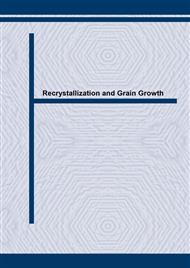p.545
p.551
p.557
p.567
p.573
p.579
p.585
p.591
p.597
Using Electron Backscatter Diffraction (EBSD) to Measure Misorientation between ‘Parent’ and ‘Daughter’ Grains. Implications for Recrystallisation and Nucleation
Abstract:
Electron backscatter diffraction (EBSD) is an extremely valuable tool, as it measures full crystallographic orientation information. This technique has been used to measure the statistics of misorientations between original ‘parent’ grains and recrystallised ‘daughter’ grains in a mylonitic quartzite. The angle of misorientation has implications on the controlling recrystallisation mechanism. The sample is a natural mylonitic quartzite collected from the stack of Glencoul, NW Scotland. The sample exhibits a common partially recrystallised microstructure. The data shows the average misorientations between the ‘parent’ and ‘daughter’ grains are 30º, this value seems too high for only subgrain rotation recrystallisation to be taking place. Moreover there is no gradation in the boundary misorientation from the internal substructure of the ‘parent’ grain to the ‘daughter’ grains. The internal substructure size of the ‘parent’ grain is bigger than the size of the ‘daughter’ grains. For subgrain rotation recrystallisation you may expect to see a core and mantle structure and for the ‘daughter’ grains’ to be of similar size to the internal substructure of the ‘parent’ grain. Another mechanism has either controlled the recrystallisation altogether or has become active after subgrain rotation had taken place and modified the microstructure.
Info:
Periodical:
Pages:
573-578
Citation:
Online since:
October 2004
Authors:
Price:
Сopyright:
© 2004 Trans Tech Publications Ltd. All Rights Reserved
Share:
Citation:


